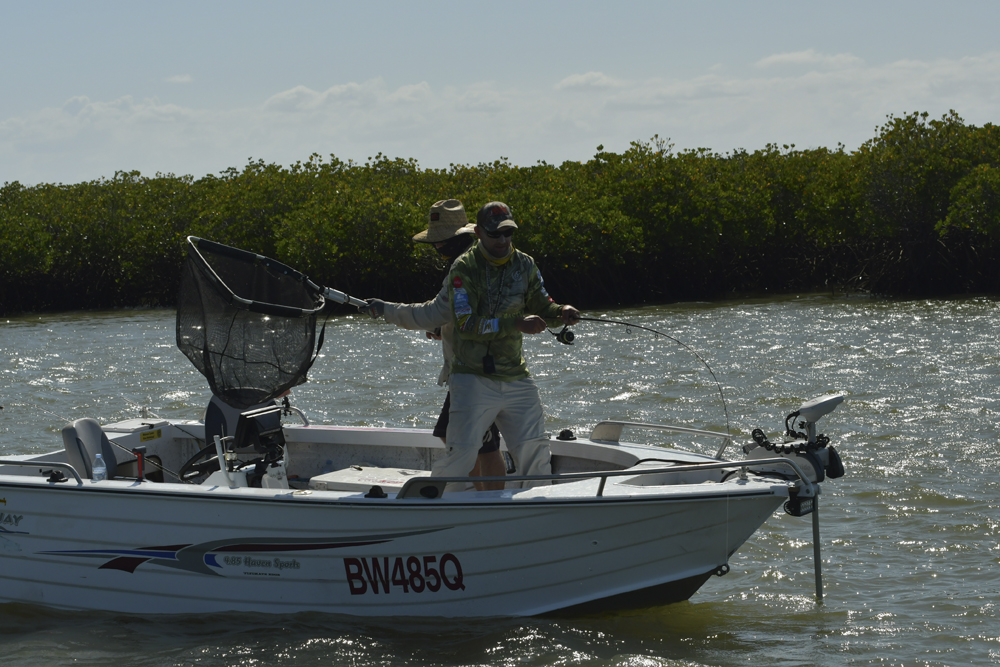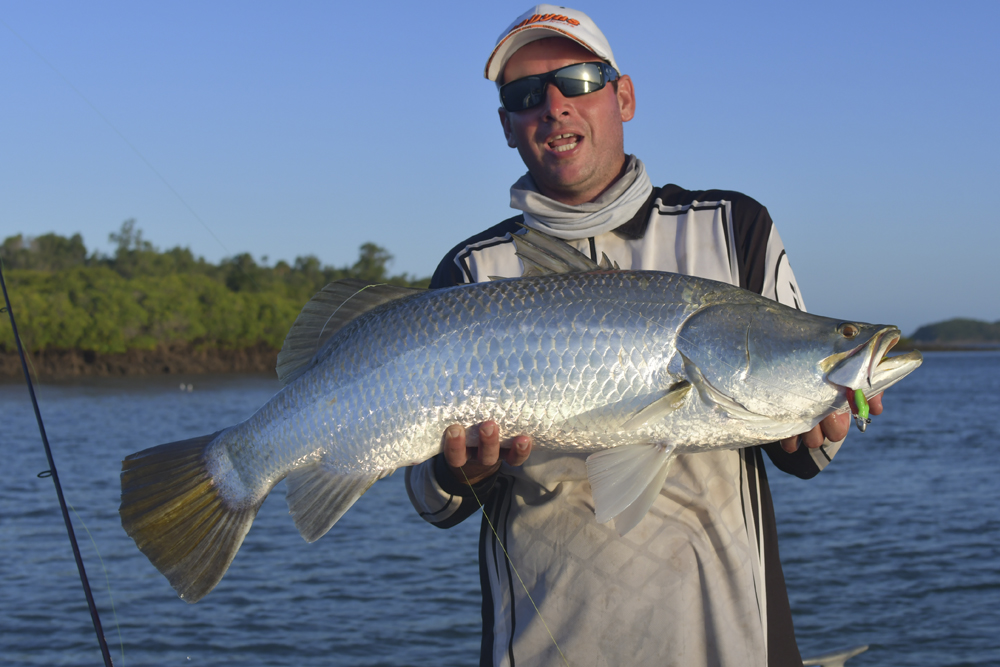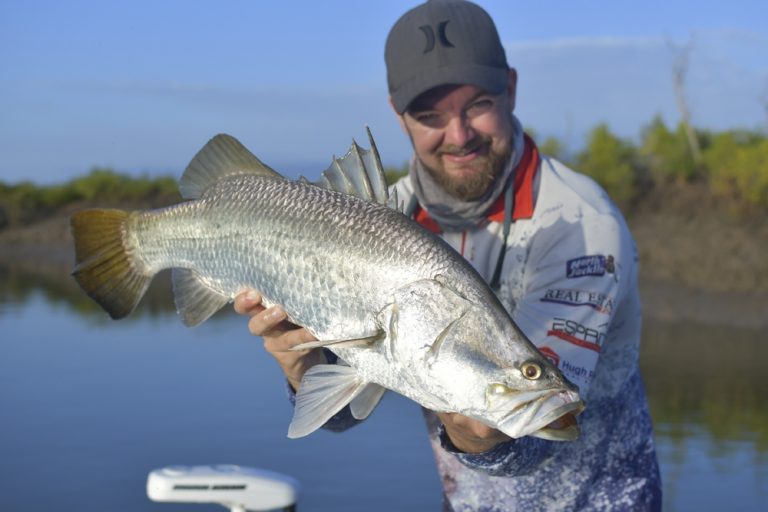The Fishing Machines of Rockhampton – By Lee Brake
I worked late on the Sunday and then packed the last of my gear before hitting the road from Mackay to Rockhampton. When I finally pulled up in the Boon family driveway, it was close to 10pm, and I was looking forward to a beer and a chin-wag to plan the next day’s fishing.
I fully intended to leave my gear in the car and unpack in the morning, but my host gently torpedoed that idea.
“We are getting up early,” fellow Fish and Boat scribe and Rocky-local John Boon said.
“How early?” I asked.
“Stupid o’clock,” he replied with a mirthless grin.
“What’s that, like 5am?”
“Nah, 2…”

I didn’t waste too much more time discussing that plan – it’s best not to argue with madmen…
And when you are in a new location fishing with locals, you just trust that they know what’s what. Boony has the runs on the board, so I was willing to trust him. It didn’t really matter, I was wired from the road and built-up excitement, so didn’t sleep a wink anyway.
I was in town to test the waters. I’d been meaning to fish Rocky ever since their net free zone started firing, and an invite from John to fish hard for a few days during the start of the barra season was too good to pass up.
Honestly, I had no idea what to expect, and John’s reply to my questions of what to bring didn’t help. “Umm, just bring a bit of everything. We’ll do a bit of everything, but make sure you have gear with a lot of stopping power.” And with that, he sent me a Humminbird screenshot of some gnarly structure in less than 10m of water with at least twenty big barra clearly schooling on it.
I brought a lot of gear, but definitely went too heavy. The kind of fishing they do requires finesse and mostly involves vibes under 30grms and lightly-weighted plastics. I mostly bought gear that you’d use to troll 8m divers or jig inshore rubble patches.

We ended up fishing Port Alma, as the Fitzroy was in flood and looked like someone had vomited a bowl of salad and Coco pops into it.
Port Alma blew me away by how different it is to the systems around Mackay. I knew this area was a different kettle of fish before the sun had even come up on that first day because Boony was driving Luke Peisker’s TABs like he’d stolen it – full noise in the dark with just a thin spotlight and a GPS to follow. “Lee looks a bit worried,” Luke said from the other side of the centre console, and to be honest, my hands were gripping the console’s rail like it was my last cold stubbie during a heat wave.
“As long as you guys know where the sandbars are, I trust you,” was my reply.
“You don’t have to worry about sandbars here mate,” he said.
He wasn’t wrong. Over the next two days of serious fishing, I don’t think I saw a single sandbar, even at the bottom of the tide. Port Alma is deep. Its banks are steep and mostly sheer mud with the occasional area of shale or red dirt. Fringing mangroves are fairly sparse, and the canopy is usually up and out of the water, except at the very top of the tide. It was the complete opposite to what I am used to around Mackay, though it did remind me a little of the Proserpine River.
What this meant was that a lot of the fish-holding structure was actually below the surface. Without a sounder, you would have been lost, and let me tell you that Rockhampton anglers take the art of fishing with sounders to a whole new level. Everyone has a side-scan sounder. I saw multiple beat-up tinnies under 4m running 12” sounders that would have been worth double the price of the hull. It blew my mind!
It also means that they fish completely differently – where I have always looked for an ingredient list of things when picking spots (structure, current, shade, depth etc.), the rocky anglers just look for fish. They literally fish, fish. They go scanning with their Helix and Solix units (for the most part) and mark schools of fish. They then return to areas where they know schools congregate. Mouths of gutters and feeder creeks were regular spots, as were bank slips – areas where it looked as if a giant had taken a bite from the bank. Sounding in front of these “bites” would usually show up muddy lumps and chunks and a slight ridge that made a sub-surface current-break preferred by ambush predators like barra. However, often the schools were nowhere near where you’d expect them to be. John and Luke took me to one nice looking feeder creek mouth, one that actually had some fallen bank-side vegetation. They scanned it for a few minutes and then went back into the main creek system, travelled about 100m and scanned a blank, boring stretch of mud bank – there was the school. Clear as day a dozen barra could be seen sitting in about 2m of water on nothing – not even a sniff of structure!

Once they found fish, soft vibes and ZerekPrawns were the favoured lures. Hardbodies were probably used less than 15 percent of the time, though we did resort to trolling on one occasion where the barra were just stacked up on the sounder, and we’d tried everything to get them to bite. And that was really the name of the game – getting them to bite. Finding fish was easy! I’ve never seen so many big barra in all of my life, albeit they were all on a sounder screen. Without a word of a lie we would have scanned up between 200 and 300 barra over two days, maybe more – I lost count. It’s such a healthy fishery, but the barra are big and smart, and they don’t fool easily or feed constantly. Bite windows really came into play and despite my exhaustion, and the fact that we’d fished a 13+ hour day on Monday, we were back up at stupid o’clock to catch the dawn bite on day two. And, unlike day one, which was all about the big threadfin salmon (I got my PB – a 121cm model), day two proved well worth braving the dawn sandfly swarms.
We had found a school of fish the day before in a new location, and that was something Boony and Luke were pretty excited about. I got the feeling that many of the main schools were heavily targeted and as such had become a bit lure shy. Finding new targets was better. We’d found one in a very likely location that combined two of the above ingredients – a small feeder creek mouth and a bank slip just on the downstream side of the main system. A quick scan located a compact school exactly where they should have been – in the lee of the bank slip just down from the mouth of the feeder creek. We spot locked in a position that allowed us to work our offerings with the current and through the school.
Dawn came and went, and we survived the main sandfly onslaught – just. We were beginning to think the school wasn’t going to play. Had we done another “stupid o’clock” start just to offer ourselves to the sandflies? We discussed moving on, but after a quick roundtable, decided to give it just a fraction longer. It was a good call. Suddenly, they bit!
Boony hooked up first on a Zerek Prawn, and it was a good fish that got up and dancing a few times. Luckily, the hook was well placed in the corner of the jaw, and Luke soon had the net around it. What followed was a flurry of photos, video and tagging – Boony has a system when a big fish comes aboard, and it’s pretty hectic, but the result is that the fish gets back into the water quickly and swims off strongly. I was on two casts later. A white Threadybuster vibe did the damage. This fish was even more keen to get airborne but lacked the power of John’s fish. It ended up being 75cm, and I think I disappointed John a little by asking if he minded me keeping it. Mackay’s weather had been miserable for months, so my freezer was pretty much empty.
He was okay with it, but at the end of the day, it was me who probably regretted the decision. Boony and Luke fish harder than any blokes I have ever met and they never seem to tire. Despite being up at 2am two days in a row, we fished till dark (and after) both days. Filleting after fishing for 15 hours is borderline unsafe. I was a drooling, senseless zombie – they seemed fine!
But I digress. The bite slowed after that and while a few cod and what was likely a large shovelnose shark followed, we really struggled to get them to bite again. It’s not that we didn’t find fish – there were plenty showing, but they just wouldn’t bite. By the afternoon I’ll admit that I nodded off for half an hour while “resting my eyes” – no ticker these Mackay anglers!
By 3pm we started running out of steam – well, I certainly did. The fish had gone quiet, and despite finding plenty on the sounder, we hadn’t produced another decent barra bite. Finally, Luke and John opted to pull the pin… and travel to another creek.
We pulled the boat out at Port Alma, hiked into town, replaced some lost lures at Barra Jacks and then put in at Coorooman Creek.
Coorooman is a beautiful system and has a lot more bankside vegetation and plenty of rocky mangrove flats. In fact, it was one of these rocky flats we were fishing because Luke had been there the day before I’d arrived and boated a 114cm silver slab while fishing solo – a herculean effort!

And the big fish were clearly there again. I was fishing down the back near the 12” Helix and watched a procession of perfectly barra-shaped shadows go under the boat while we fished.
I got a nice thump on my Reidy’s vibe just before dusk, and Boony got one not long after and retrieved his vibe complete with a big barra scale on one of the trebles. However, it was Luke who came up trumps again. He was using a little three-inch Zman plastic, and at first glance, I was picking the barra that was leaping in the dusk glow as over a metre. It wasn’t – it was in the high 90s and fought like a demon before I finally got the net under it for Luke.
It was a hell of a way to finish a few good days fishing for me – I piked on the boys the next day. They were planning another morning fish and offered that I could come with them and then drive home in the afternoon, but I opted to sleep in and head home in the morning. Honestly, fishing with those Rocky blokes just about killed me. They’re fishing machines!
Postscript: Since I’ve been back, I’ve upgraded the sounder in my Hornet and convinced the old man to lash out and buy a Humminbird Solix. I can report that the barra schools are just as prevalent in our Cape Hillsborough to St Helens Beach Net Free Zone. I can also report that just because you can see them, doesn’t mean they will bite. But I’m heading back on Monday with a few ideas that might just work – will let you know how they go.
Fish hard and stay safe, Lee.





